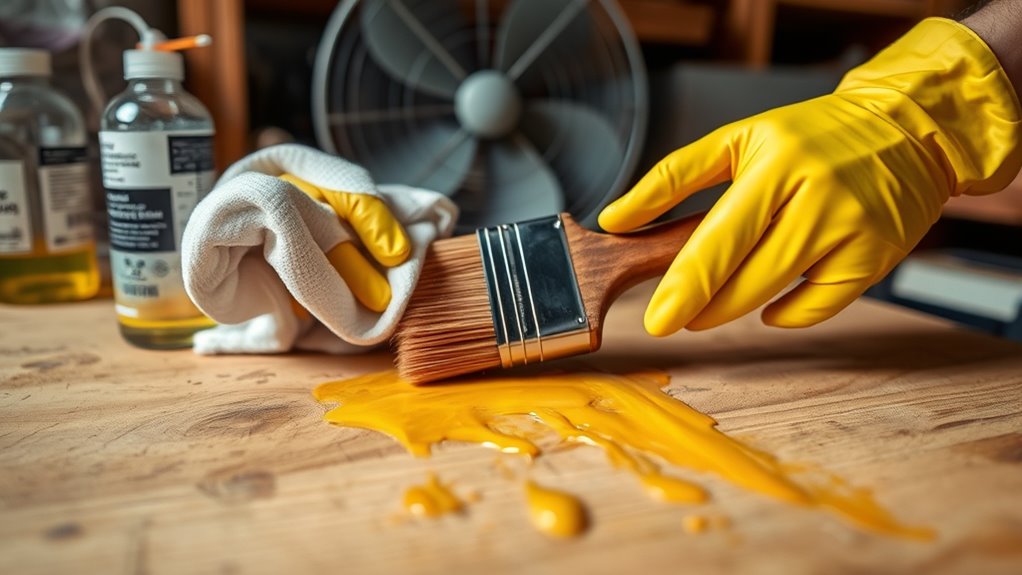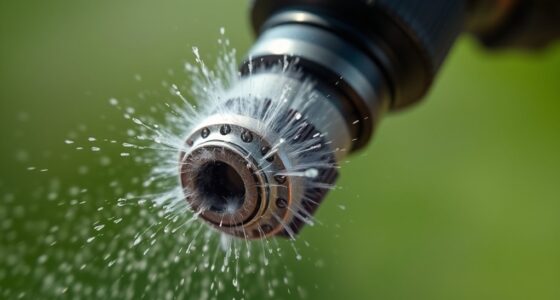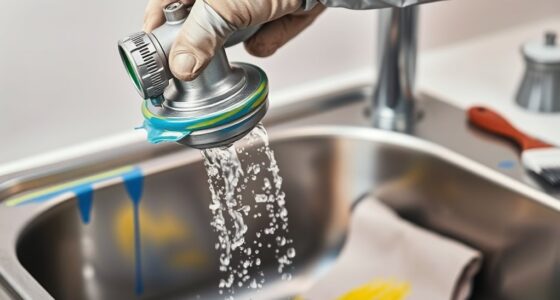After using oil-based paints, you should first clean your brushes and tools with solvents like mineral spirits or paint thinner, then rinse with soap and water to prevent damage. Wipe down surfaces to remove splatters and use odor absorbers if smells linger. Proper disposal of waste and regular cleaning help prevent odors and preserve your tools. Want to learn more tips to keep your workspace clean and odor-free? Keep going for your complete guide.
Key Takeaways
- Thoroughly clean brushes and tools with mineral spirits or paint thinner, then rinse with soap and water.
- Wipe surfaces with solvent or soap-water mixture promptly to remove paint splatters and prevent stains.
- Use odor absorbers like baking soda or activated charcoal to neutralize lingering fumes after cleaning.
- Dispose of used solvents, rags, and paint remnants responsibly following hazardous waste guidelines.
- Organize and clean your workspace and tools after painting to prevent odors and maintain safety.

Cleaning oil-based paints can be challenging, but with the right techniques, you can effectively remove paint residue and stains. One of the most vital steps after your painting project is thoroughly cleaning your tools and workspace to prevent lingering odors and damage. To start, you’ll want to select a good paint remover suited for oil-based paints. This product helps break down the paint, making it easier to clean off brushes, rollers, and other equipment. Applying the paint remover according to the manufacturer’s instructions ensures you loosen the paint effectively without harming your tools or surfaces. Be sure to work in a well-ventilated area and wear gloves to protect your skin from harsh chemicals.
Effective oil-based paint cleanup starts with choosing the right remover and working in a ventilated area.
Once the paint remover has done its job, the next step is brush cleaning. This process is essential because residual paint left on brushes can harden, making future cleaning more difficult and potentially damaging the bristles. To clean brushes thoroughly, dip them into a solvent like mineral spirits or paint thinner, and work the solvent into the bristles by swirling and pressing. This breaks down the oil-based paint, allowing it to wash away easily. After the bulk of the paint is removed, rinse the brush with soap and warm water to eliminate any remaining residue. Proper brush cleaning not only prolongs the life of your tools but also reduces the risk of paint buildup that can cause odors or damage when left to dry. Additionally, using appropriate cleaning products can further enhance the effectiveness of your cleanup routine.
In addition to cleaning tools, it’s essential to clean your work area to prevent paint stains and lingering odors. Wipe down surfaces with a solvent or a mixture of soap and water, depending on the surface material. Pay special attention to spots where paint may have splattered or dripped. Removing these promptly helps avoid stubborn stains and minimizes any smell that could develop over time. If you notice odors lingering after cleaning, consider using odor absorbers like baking soda or activated charcoal placed in the space. These will help neutralize any remaining fumes, making the environment safer and more pleasant.
Finally, dispose of used paint remover, solvents, and rags responsibly, following local hazardous waste disposal guidelines. Proper disposal prevents environmental contamination and safety hazards. When everything’s cleaned and organized, you’ll not only protect your tools and surfaces but also guarantee your workspace remains safe and odor-free. With patience and the right cleaning techniques, you can keep your tools in top shape and avoid the headaches associated with residual paint and odors after your oil-based painting projects.
Frequently Asked Questions
How Long Do Oil-Based Paints Typically Emit Odors?
You might wonder about the paint odor duration after applying oil-based paints. Typically, the strong paint odor can last from 2 to 14 days, depending on ventilation and humidity. To speed up odor elimination, open windows, use fans, and place bowls of activated charcoal or baking soda around the space. These odor elimination tips help you enjoy your freshly painted room sooner and reduce lingering smells effectively.
Can I Use Natural Cleaners to Remove Paint Residues?
They say “what’s good for the goose is good for the gander,” so yes, you can use natural cleaners to remove paint residues. Natural remedies and eco-friendly solutions like vinegar, lemon juice, or baking soda can be effective. Just make certain you test a small area first. These options are gentle yet effective, helping you clean without harsh chemicals, and promote a safer, healthier environment in your home.
What Safety Precautions Should I Take During Cleanup?
During cleanup, you should wear protective clothing like gloves and goggles to avoid skin and eye irritation. Make certain good ventilation by opening windows and using fans to disperse fumes safely. Avoid inhaling paint vapors and wash your hands thoroughly afterward. These ventilation tips and protective gear help keep you safe from harmful fumes and potential skin contact, making your cleanup process safer and more effective.
Is It Necessary to Wear Protective Gear When Cleaning?
You should definitely wear protective gear when cleaning after using oil-based paints. Protective gear enhances your cleaning safety by shielding your skin and eyes from harmful fumes and chemicals. Gloves, goggles, and a mask are essential to prevent skin irritation and inhalation of toxic vapors. Taking these precautions keeps you safe, minimizes health risks, and ensures a smoother, worry-free cleanup process. Always prioritize safety during cleaning tasks involving hazardous substances.
How Do I Dispose of Leftover Paint and Cleaning Supplies?
When it comes to paint disposal and cleaning supplies, you need to follow proper procedures. Avoid pouring leftover paint down drains; instead, take it to a local hazardous waste facility. For cleaning supplies, use eco-friendly methods or dispose of them according to your local regulations. Always store leftover paint and supplies safely until disposal, and never mix different chemicals to prevent dangerous reactions. Proper disposal helps protect your environment and health.
Conclusion
Now that you’ve learned to clean up oil-based paints properly, you’d think it’s a breeze, right? But here’s the irony: the very effort to prevent damage and odors can turn into a lingering battle if you’re not careful. It’s almost poetic—your attempt to keep things pristine might leave behind stubborn stains or smells that stick around longer than the paint itself. So, enjoy your spotless space, just don’t be surprised if the cleanup becomes the real masterpiece.
Franz came aboard the Paint Sprayer Zone team with a background in both journalism and home renovation. His articulate writing style, combined with a passion for DIY projects, makes him an invaluable asset. Franz has a knack for breaking down technical jargon into easy-to-understand content, ensuring that even the most novice of readers can grasp the complexities of paint sprayers.










